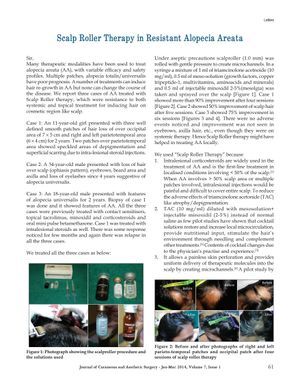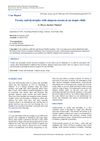Scalp Roller Therapy in Resistant Alopecia Areata
January 2014
in “
Journal of Cutaneous and Aesthetic Surgery
”
alopecia areata Scalp Roller therapy microchannels triamcinolone acetonide meso-solution growth factors injectable minoxidil contact sensitisers topical tacrolimus minoxidil corticosteroids oral mini pulse betamethasone AA Scalp Roller micro-needling Kenalog mesotherapy Rogaine tacrolimus steroids betamethasone

TLDR Scalp Roller therapy helped improve hair growth in patients with hard-to-treat alopecia areata.
The document reports on three cases of resistant alopecia areata (AA) treated with Scalp Roller therapy, a method that involves creating microchannels in the scalp to facilitate the delivery of a therapeutic mixture. The mixture contained triamcinolone acetonide, a meso-solution with growth factors and other nutrients, and injectable minoxidil. The three patients, who had not responded to previous treatments including contact sensitisers, topical tacrolimus, minoxidil, corticosteroids, and oral mini pulse betamethasone, showed significant improvement after undergoing Scalp Roller therapy. The 11-year-old girl (Case 1) had a 90% improvement after four sessions, the 34-year-old male (Case 2) had a 50% improvement of scalp hair after five sessions, and the 18-year-old male (Case 3) had a 75% improvement in six sessions. No adverse events were reported, and the improvement was localized to the scalp, with no effect on eyebrows or axilla hair. The study suggests that Scalp Roller therapy could be an effective and safe adjunct treatment for resistant AA, but acknowledges that randomized controlled studies are needed to confirm the efficacy of this multimodal approach.

